
I was down on the ground, hands in the dirt, pulling away at a weed with spaghetti-like roots that stretched underground and all along the periphery of my backyard. My neighbour must have heard my frustration through the fence.
“That’s gout weed,” she said. “Good luck. I’ve been pulling it for 55 years.”
My friend Laura was over. Our boys were playing together with their diggers nearby, unknowingly transplanting bits of weed in the buckets of their trucks. Laura comes from a long line of incredible gardeners. She sensed my overwhelm.
“My mother always says to start with a square foot in the garden,” Laura said. “Don’t look left or right, just stay in that space.”
That was over ten years ago, but I still hear those words when I’m overwhelmed. Focus on this square foot. Don’t look left or right. Just stay in that place.
Overwhelm is normal this time of year. I’ve written about Christmas tears many times (specifically here), but this year seems supercharged. It’s hard when we can’t gather as usual. It’s hard when family members are in quarantine. It’s hard when a pandemic crushes the economy. It’s hard when Christmas parcels are delivered then promptly stolen from doorsteps.
And then there’s the problem in the kitchen. Some find solace there, but others, they’ve had it. Even Helen Rosner, a James Beard award winning food writer, recently wrote a piece for the New Yorker titled The Joylessness of Cooking. Rosner says she started out strong in the early days of the pandemic. She “stir-fried Sichuan-style cumin lamb, made slow-roasted pernil asado, fired up pots of oil for a farmers’-market fritto misto…” But now, all these months later, she’s bored and “so sick of cooking.” She calls her condition ‘kitchen fatigue’, and judging from reader responses, thousands of people have been plagued with the same thing.
Like my cousin Claire in Toronto, who works from home and has been feeding boys (and bumping into them all day, everyday) since March. Last week she tweeted this:
“I’ve had it with endless cooking and think we should try to be more like boa constrictors, like eat a goat and lie around for a couple weeks.” The replies were just like Rosner’s:
“I hate cooking.”
“I wished the exact same thing!”
“Amen, sister.”
But then there was this tweet:
“I had a huge aha moment last night…sheet pan dinners rock.”
That night I pulled a roasting pan from the oven, full of roasted shallots, garlic, fennel and thyme, topped with fat, nicely browned chicken breasts. It’s a recipe from The Roasting Tin, a present from my cousin Betsy in the UK. Betsy swears by this book and this method of cooking in general. Regardless of what you call the cooking vessel – roasting tins, sheet pans, cookie sheets, lasagna dishes – the idea is the same: mix ingredients in one pan, slide it in the oven, et voila, your dinner is served.
“One-pan wonders” have been sweeping the internet for a while now. But it wasn’t until I pulled the pan from the oven and laid it on the counter that it hit me why – this pan is the rectangular, culinary version of the gardener’s square foot. Focus on this square foot. Don’t look left or right. Just stay in that place.
The roasting pan corals your overwhelm. It puts it in one tidy spot, providing enough nourishment to move you along to the next square-foot in your life that needs attention.
I finished off the dish with the recommended sauce: mayonnaise whisked with dijon and honey. It was so easy.
PS – Hope you all have a restful, tear-free Christmas. I’ll be back in 2021 with, undoubtedly, re-set recipes and stories of Christmas past. Until then.
PPS- Thank you to Jennifer Crawford for the preserved lemons that I swapped in for fresh in the above recipe. So good.
